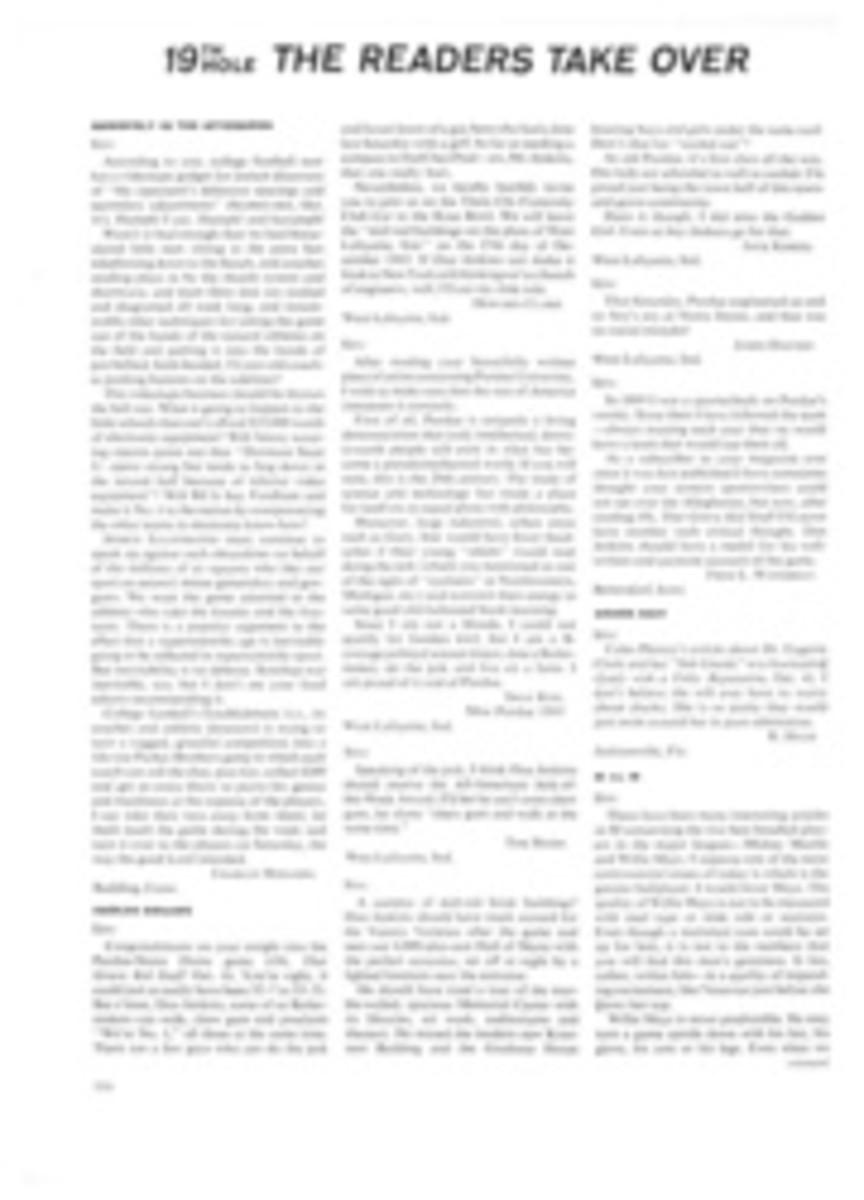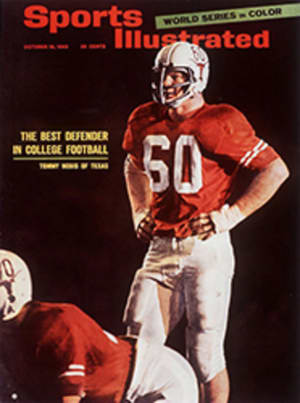
The Case for Faith in the Babe's Called Shot
While Babe Ruth's records steadily crumble under the never-ending assault of newer bats and younger muscles, there is always some consolation for older fans in memories of the epic Called Shot—there, at least, is something no one will ever duplicate or surpass. When all of Ruth's official records are dust he will still be enshrined in that glowing October afternoon during the 1932 World Series when he pointed in lordly scorn to the distant bleachers and then detonated the next pitch to the exact spot. Or will he?
No one knows when baseball's No. 1 great moment first began to show signs of erosion, but for at least two decades there has been a steady undercutting of the story among baseball people. By 1957 Baseball Digest was able to publish an article in which all of the evidence against the Called Shot was rounded up and neatly tied with black ribbon. Herbert Simons, author of the article, very logically went back to some of the old newspaper accounts of the game and also talked to the two men who, presumably, were closest to the big moment, Yankee Manager Joe McCarthy and Charlie Root, the Cub pitcher who served up the fated pitch. Simons reported that of the nine leading sportswriters he had checked none had anything to say about the Called Shot. In addition, he quoted a denial from Root ("If I had thought he had tried to show me up I'd have knocked him right on his tail!"), and he pictured Joe McCarthy tortuously refusing to deny the story but also unwilling to affirm it outright.
A difficulty for the historian is that a personality like Ruth's breeds legends. His admirers added touches of their own to his flourishes. He hit a home run in the first game after his marriage on April 17, 1929. But did he really stop after he crossed second base and doff his hat to his bride? There are those who swear he did. The skeptics are likely to see myth even in the facts. So it has been with the Called Shot.
Simons admitted that Ruth had done some clowning that memorable afternoon 33 years ago, including calling strikes on himself by waving his fingers in the air, and in one of these offhand gestures he identifies the source of the Called Shot: "What a few romantically interpreted as 'pointing' was merely a sweep of his hand as he brought it down."
Legends are not so easy to kill, of course, and the Digest article did not prevent longtime sportswriter Allison Danzig from selecting the Called Shot as baseball's greatest moment in his monumental History of Baseball. All the same, the legend had been given another shove toward oblivion. It did seem incredible that not even one of the writers mentioned by Simons should have recorded something about Ruth's fabulous gesture if it had really happened. Or else Simons, wading through the ocean of newspaper copy that had flowed out from Wrigley Field that afternoon, had missed something. Before I was willing to let that grand tableau fade into the light of common day, I decided to spend a nostalgic afternoon or two in the library checking Simons' sources.
The lengthiest quote Simons provided was from a story by Richards Vidmer in the New York Herald Tribune, and he remarks of this account, "Beautiful descriptive writing—but notice not one word about a 'Called Shot.' " I had not spent much time reading the original Vidmer story under the dull glare of the microfilm machine before I realized that there is comment about the Called Shot that Simons for some reason had not quoted: "The very first time he came to bat in the opening inning, there was confidence in his manner as he stepped up to the plate. He paused to jest with the raging Cubs, pointed to the right-field bleachers and grinned."
Well, that was something, but unfortunately it referred to the first inning and not the fifth, in which the titanic homer was hit. But if Simons' questing eye could completely overlook those bothersome little sentences, I thought, perhaps further digging might yield richer ore. The only other account Simons quoted at some length was by John Drebinger of The New York Times. I read the original Drebinger account side by side with the article and couldn't suppress a slight yelp of triumph as I came across the following sentence: "In no mistaken motions the Babe notified the crowd that the nature of his retaliation would be a wallop right out of the confines of the park."
It was hardly fair of Simons to have kept that back from his readers. Now we had two mentions of a Called Shot where there were supposed to be none!
Simons does not deny that a few days after the Series ended there were scattered references to the Called Shot in the papers, but he insists that the first mention did not appear until three days after the game. That would mean the papers of October 4. I began plowing through some papers of October 3. The New York Daily News for that day carried its regular column by Paul Gallico, which was datelined October 2. The column was all about Ruth, and it included the following: "He pointed like a duellist to the spot where he expected to send his rapier home and then sent it there. He went so far out on a limb with his gestures and his repartee and his comportment at the plate, that if he had missed he would never have been able to live it down.... The Babe now held up two fingers and shook them so that they seemed to reach right into the Cub dugout. And this time it was probably the most daring gesture ever made in any game. Because it meant that he intended to knock the next one out of the park."
After reading that I admit I had a feeling of exultation. It was tantalizing to wonder what a systematic search of all the country's newspapers for Oct. 2, 1932 would reveal, but having turned up three new contemporary mentions I felt I had gone far enough. The case, as far as I was concerned, was wide open again, and Ruth was back on center stage. That conclusion was strengthened even more when I reread the two excerpts that Simons had quoted only in order to discount.
Bill Corum on October 4: "Words fail me. When he stood up there at bat before 50,000 persons, calling the balls and strikes, with gestures, for the benefit of the Cubs in the dugout and then, with two strikes on him, pointed out where he was going to hit the next one, and hit it there, I gave up. The fellow's not human."
Tom Meany on October 4: "Babe's interviewer then interrupted to point out the hole in which Babe put himself Saturday when he pointed out the spot in which he intended hitting his homer."
What, I wondered, actually did happen that day? After all, it wasn't so long ago. Why so much doubt and debate about an incident that supposedly took place in full view of a huge and avid crowd? Now, after a patient reading of many other original accounts of the game, I think I can offer an answer to that question. Ruth did call his shot, and it is only because we take the thing so seriously today that we find it hard to believe.
The Yanks had won the first two games of the Series in New York with Ruth contributing practically nothing. He had been in baseball 19 years, was on his way out and the Cub fans weren't backward about telling him so. But Ruth was always ready to do battle, and all during the third game he strutted, wisecracked and hurled insults. The fans jumped on him in the bottom of the fourth inning when he tried to make an impossible shoestring catch, kicked the ball back toward the infield, chased after it, fell on it and did everything but dig a hole and bury it. The runner stopped at second.
At bat in the top of the fifth, Ruth spent a good deal of time stepping out of the box and shouting gibes at the Cub bench. It is impossible to say what the count was, since the reports vary, but it is certain that Root had blown two strikes past him. After each of them the Babe indicated the situation to all and sundry by waggling his fingers in the air. This was baseball's supreme player in the twilight of an incredible career but still the dominating personality on the American sports scene. Now, in one electric moment, all of the old bravado and vestiges of the once-great skills suddenly rose up again. He pointed, definitely and deliberately, toward the distant stands. It was a hurried gesture missed by many in the big park, but it was Ruth's quintessential moment of triumph. He had never done such a thing before, and (if he had stopped to think about it at all) he knew he could never do it again, but just this once he had put down all his chips. Then Charlie Root tried to whip over a third strike, Ruth swung and the ball soared into the bleachers. It hasn't stopped yet, and I think it never will.
PHOTO
THIS WAS THE SWING INTENDED TO MAKE GOOD ON THE BABE'S GESTURED PROMISE TO HIT THE BALL INTO THE BLEACHERS
PHOTO
THE SHOWMAN HAD HIS SERIOUS SIDE

